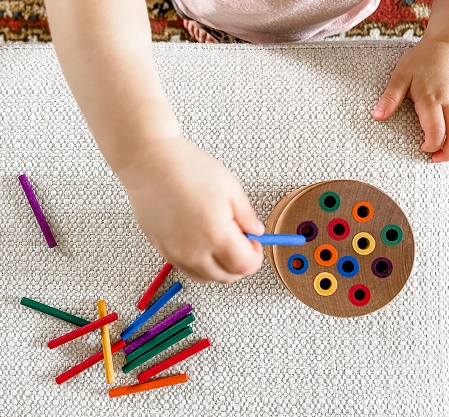Approved training videos related to typical development of young children.
Typical Development
This video is grouped in pre-locomotion and locomotion sections to enhance the viewer’s observation skills and understanding of the natural progression of the baby’s movement development, preverbal communication, and play interactions
This video helps the viewer discover how babies move to learn, communicate and interact in their environment.
Follow the journey of a baby’s phases of attachment from birth to age two … See examples of how parents and caregivers can foster healthy attachment relationships. Attentive, responsive, and loving care given by a baby’s primary caregiver sets the foundation for a child’s capacity to form these relationships throughout life.
Children need to move! Not only to improve their physical development, but also to enhance their social, emotional and cognitive development. Movement really does benefit the whole child. Join us, as we interview children’s physical development specialist, Rae Pica, to learn about making movement activities meaningful for all areas of development.
A video guide to child development and appropriate ways for parents to help their children learn and develop. The developmental periods are divided into 0-3 months, 3-6 months, 6-12 months, and 12-24 months. Some of the topics include: physical growth, breastfeeding, bottle feeding, sensory development, touching and bonding.
This program charts the development of language during childhood. Basic language acquisition, learned from rudimentary and higher-level child/caregiver interactions, is described. Aspects of competence that go beyond the purpose of simple communication are also considered.
Uses photography, computer graphics, and 4-D imaging to show the development of a female human fetus from conception to birth.
National Geographic explores the fragile world of twins, triplets, and quadruplets in utero. Featuring 4-D ultrasound images and new fetal imaging techniques. Closed-captioned.
Follow an infant’s rapid physical development in the first year of life. See how a baby’s brain develops and how infants fit into the sensorimotor stage of development. Experts weigh in on the subject. We also provide tips to parents and caregivers for ways to foster the growth and development of young children.
Explore infant intelligence, information processing and memory. See the progression of infant communication from crying–to giggling–to euphoric babbling and their first words! Understand how language is learned and how caregivers can use infant-directed speech to foster cognitive development.
Learn the importance of proper nutrition and sleep in the first year. See how infants rely on their innate reflexes and how gross and fine motor skills emerge in typically developing children as well as those with challenging conditions.
Examine the different stages of emotional development, and learn how children form attachments with people. Observe how personality and temperament affect an infant’s social and emotional growth and how caregivers handle various situations.
This video discusses typical developmental stages of vision, the different signs of vision impairments to look for in young children, the impacts of vision on a child’s development, and the relationship between vision issues and a diagnosis.
This video, from the Tender Care Infant-Toddler Series, shows both younger and older babies and toddlers in several High/Scope infant toddler settings and the adults who care for them. Included are strategies for problem prevention, positive limit setting, and resolving conflicts.
Features 30 video vignettes that show parents and children – aged birth to three years – interacting during playtime and everyday routines. The vignettes capture how learning unfolds through loving interactions with parents and caregivers, and highlgith the critical role that adults play in supporting children’s healthy development.
Demonstrates that the energy and exploration of two year olds are means of learning about their bodies, minds and the world around them. Show children actively increasing physical abilities, making new mental connections, increasing their language skills and learning to deal with emotions and social situations. Discusses how body awareness and language and motor skills are related to toilet training, and how routines provide security and comfort. Closed captioned.
Illustrates how developing a set of well-though-out rules, ritual and routines will make parents’ lives easier and their children happier and well-behaved.
This video follows the growth and developments from newborn to toddlers, including how they explore, what they see and hear, how they communicate, and the importance of the first three years.
- Episode 1: The Baby’s Brain: Wider Than the Sky. Examines how the brain builds itself from conception through the first year of life. This video follows a three month premature infant to reveal that these brains may develop differently and whether providing a special environment that mimics the womb can make a difference. Closed captioned.
- Episode 2: The Child’s Brain: Syllable From Sound. Until babies reach about a year old, they respond to language with their entire brains, but then, gradually, language shifts to the left hemisphere. But what happens if, during childhood, the left hemisphere is compromised by disease? This video follows a young man who had his left hemisphere surgically removed to cure a rare brain disease. The neurologist attempts to learn how the right side of the brain has compensated. Closed captioned.
Presents normal infant development with emphasis on hearing, speech, and language development. The video also discusses the credentials and services of speech language pathology and audiology. Age-specific milestones are addressed. This video is for parents and professionals and provides examples of normal speech, language, and hearing development, as well as tips on when parents should seek treatment.
This video, part of the I am Your Child Video Series with host Ray Romano, provides information on how fathering begins even before birth, how dads can connect with their children right from the start, what fathers can do to foster a close relationships with their children even when they live miles apart and how fathers can overcome the challenges of parenting under special circumstances, like separation and divorce.
Looks at the development of symbolic thinking and pretend play in the toddler. The child also learns to communicate with individual words and short sentences during this time period.
Learn about the physical characteristics of toddlers, and how gross and fine motor skills are developed. Understand the milestones children achieve at this age by observing toddlers in learning centers and at home. Hear from the experts about nutrition, sleep, toilet training, and developmental differences among toddlers.
Learn about the theory of the mind and how toddlers come to understand how their actions can affect others. Examine how gender and temperament play a role in development. Observe toddlers interacting with family and peers as they develop attachments and social bonds. Closed-caption included.
By watching a dozen families in unique situations, Dr. T. Berry Brazelton shows how and why children develop the way they do. Touchpoints are defined as periods of time that precede rapid growth in learning for parent and child. This DVD provides comprehensive information on development of infants and toddlers, including how to manage temper tantrums and excessive crying appropriately.
Children need to move! Not only to improve their physical development, but also to enhance their social, emotional and cognitive development. Movement really does benefit the whole child. Join us, as we interview children’s physical development specialist, Rae Pica, to learn about making movement activities meaningful for all areas of development.

The videos are assigned to a designated core content area.
Continuing Education via Video-Based Training
Since April 2006, a maximum of 5 hours of EI credit via videos may be used for every 30 hours of continuing education submitted for renewal and/or core knowledge area documentation purposes for early intervention professionals. The EI Clearinghouse has worked with the Early Intervention Training Program to identify videos available from the EI Clearinghouse lending library that have been approved for EI credit hours. While providers cannot use video-based training for all of the required training hours, they can apply for credit for at least some of the required hours. Several of these videos can be viewed online.
How Credit Hours are Determined
Video-based credits are based on contact time, so a half-hour video would equal a half hour of credit, a one-hour video would equal one hour of credit, etc. Each video viewed requires the completion of an EI Training Video Credit Request Form, which is to be sent to the EI Training Program when completed. After your information is reviewed and approved, you will receive a Certificate of Credit indicating that you have earned contact hours equal to the video running time (to the nearest quarter hour) to apply toward your EI credential. Please contact the Early Intervention Training Program for more information.
How to order videos
- Please use our Online Request Form for questions and material requests.
- Materials check out for 4 weeks
- You may check out up to 5 items at a time.
- You may request to renew items 2 times (as long as there is not another request for that item).
- You will receive information with the books or videos on options for returning the materials.
